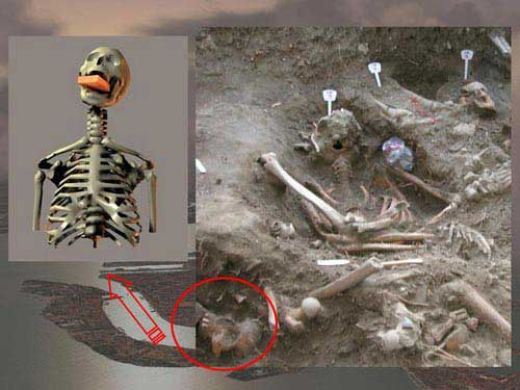Arnold Paole (Arnont Paule in the original documents; an early German rendition of a Serbian name or nickname, perhaps Arnaut Pavle; died c. 1726) was a Serbian hajduk who was believed to have become a vampire after his death, initiating an epidemic of supposed vampirism that killed at least 16 people in his native village of Meduegna (also rendered as Metwett; likely a German rendition of Serbian Medveda, not to be confused with the modern Southern Serbian town of Medveda), located at the Morava river near the town of Paracin. His case, like the similar case of Peter Plogojowitz, became famous because of the direct involvement of the Austrian authorities and the documentation by Austrian physicians and officers, who confirmed the reality of vampires. Their report of the case was distributed in Western Europe and contributed to the spread of vampire belief among educated Europeans. The report and its significance for the subsequent Eighteenth century vampire controversy are nowadays explained with the poor understanding of the process of corpse decomposition at the time.
Knowledge of the case is based mostly on the reports of two Austrian military doctors, Glaser and Flückinger, who were successively sent to investigate the case.
Background
With the Treaty of Passarowitz (Požarevac, 1718), the Habsburg Monarchy annexed most of Serbia and the northern part of Bosnia, territories which had been part of the Ottoman Empire. These remained in Austrian control until the Treaty of Belgrade (1739), when the Austrians were forced to cede them back to the Turks. During this 20-year period, these newly conquered boundary districts were subject to direct military rule from Vienna for strategical, as well as fiscal and other reasons. As a result of the devastation brought about by previous Austrian-Ottoman wars, these areas were in a poor condition, with scarce and partly nomadic population, little agriculture and an emphasis on cattle-breeding. The Austrian authorities sought to further economic development and attract German-speaking as well as Serbian and Bulgarian settlers to the new territories. Many of the Serbs, especially those who had immigrated from Ottoman-held areas, were recruited as militiamen (hajduks) for the protection of the boundaries in peace-time as well as regular military service at war in exchange for unalienable lots of land. It was in these communities that the earliest well-documented alleged vampire attacks were attested.
The first outbreak
This outbreak is only known from Flückinger's report about the second epidemic and its prehistory. According to the account of the Medveda locals as retold there, Arnold Paole was a hajduk who had moved to the village from the Turkish-controlled part of Serbia. He reportedly mentioned often that he had been plagued by a vampire at a location named Gossowa (perhaps Kosovo) but that he had cured himself by eating soil from the vampire's grave and smearing himself with his blood. About 1725, he broke his neck in a fall from a haywagon. Within 20 or 30 days after Paole's death, four persons complained that they had been plagued by him. These people died shortly after. Still ten days later villagers, advised by their hadnack (a military/administrative title) who had witnessed such events before, opened his grave.
They saw that the corpse was undecomposed "and that fresh blood had flowed from his eyes, nose, mouth, and ears; that the shirt, the covering, and the coffin were completely bloody; that the old nails on his hands and feet, along with the skin, had fallen off, and that new ones had grown". Concluding that Paole was indeed a vampire, they drove a stake through his heart, to which he reacted by groaning and bleeding, and burned the body. They then disinterred Paole's four supposed victims and performed the same procedure, to prevent them from becoming vampires.
The second outbreak
About 5 years later, in the winter of 1731, a new epidemic occurred, with more than ten people dying within several weeks, some of them in just two or three days without any previous illness. The numbers and the age of the deceased vary somewhat between the two main sources.
Glaser's report on the case states that by 12 December, 13 people had died in the course of 6 weeks. Glaser names the following victims (here rearranged chronologically): Miliza (Serbian Milica, a 50-year-old woman); Milloi (Serbian Miloje, a 14-year-old boy); Joachim (a 15-year-old boy); Petter (Serbian Petar, a 15-day-old boy); Stanno (Serbian Stana, a 20-year-old woman) as well as her newborn child, which Glaser notes was buried "behind a fence, where the mother had lived" due to not having lived long enough to be baptized; Wutschiza (Serbian Vucica, a 9-year-old boy), Milosova (Serbian Milošova, actually "Miloš's /wife/", a 30-year-old wife of a hajduk), Radi (Serbian Rade, a twenty-four-year-old man), and Ruschiza (Serbian Ružica, a forty-year-old woman). The sick had complained of stabs in the sides and pain in the chest, prolonged fever and jerks of the limbs. Glaser reports that the locals considered Milica and Stana to have started the vampirism epidemic.
Read more at http://theunexplainedmysteries.com/arnold-paole-real-vampire.html


2 comments:
hey is it true..
hey is it true..
Post a Comment